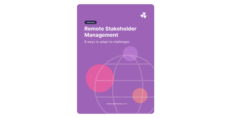Stakeholder Engagement Best Practice Guide

What do stakeholder engagement best practices look like? Understanding best practices (and following them) can help build your confidence when engaging with stakeholders while ensuring you achieve the best possible outcomes for your project, organization and any stakeholders.
Remember — stakeholder engagement is the process of engaging with stakeholders. This can include identification, analysis, planning, communication, relationship building, participation, feedback, and reporting. It’s important for sharing information, gaining insights, and increasing support so that you can make better decisions and get better project outcomes.
For more detailed definitions, check out Stakeholder Engagement: What It Means & Why It Matters.
We’ve put together a list of best practices for stakeholder professionals based on our own experiences, the International Association for Public Participation’s (IAP2) core values, and International Finance Corporation’s (IFC) key components of good stakeholder engagement.
From initial stakeholder engagement planning to communication, compliance and reporting, here are 14 stakeholder engagement best practices…

Make a Plan
Your first step should always be to make a stakeholder engagement plan. A basic plan should outline who your stakeholders are, why you need to engage them, how you’ll engage them and what outcomes you need to aim for. With a plan in place, you can ensure you have capacity within your organization to follow through with stakeholder engagement and make the most of your resources. Finally, a plan will guide you through each step, from defining stakeholders to reporting on what outcomes you’ve achieved.
Check out our stakeholder engagement plan quick start guide.
Define Your Stakeholder List
As part of your stakeholder plan, you’ll need to identify your stakeholders. List out all the different individuals, groups and organizations who are affected by or may have an influence on your project or organization. Once you have your stakeholder list, you’ll know who you need to engage and you can start planning the messages and methods that make sense for your specific stakeholders.
Define Your Key Stakeholders
Don’t just stop at your stakeholder list – if you’ve done this properly, you’ll probably have more stakeholders listed than you can realistically engage with on a deep level.
So, decide which people and groups on your list are key stakeholders – those who you’ll need to engage with more, and those whose participation is critical to your project. Use the Stakeholder Mapping fields of Influence, Interest and Impact to segment your stakeholders and classify them. Then you’ll be able to prioritize your time and resources, focusing your efforts on them, while still broadly engaging the remainder of your stakeholder list.
Tailor Your Communication and Message
The same method of delivering or presenting your message probably won’t be right for all your stakeholder groups. Stakeholder engagement best practice means you should tailor the information to different stakeholders so that it addresses the issues they’re most concerned about, and provides it in a format that is most accessible to them.
In our article on stakeholder communication, we dive deeper into these best practices (and others!). While you’re there, you might also want to learn about stakeholder communication plans.
Be Inclusive
Recognize that your stakeholders are diverse and it’s your responsibility to offer a fair chance for all stakeholder groups and individuals to participate. You can do this by:
- Getting real data on who your stakeholders are and how they prefer to communicate
- Ensuring information is accessible in different formats (audio, video, text, online, offline, in-person, different translations)
- Planning measures that help you reach a culturally and linguistically diverse community
- Planning engagement activities and communication that maximize the opportunities for people with disabilities to participate
- Checking that the language you use does not exclude any stakeholders
Communicate Clearly
Stakeholder engagement best practice 101? Clear communication. After all, stakeholder communication is part of every interaction or information exchange between an organization and its stakeholders.
Here are some ways you can communicate more clearly:
- Present the facts objectively
- Be as transparent as possible
- Explain what’s uncertain vs what’s certain
- Show how stakeholders can share their perspective and participate
- Explain how stakeholder involvement will impact on decisions made
- Disclose information early on
- Continue to communicate throughout the life of your project
- Share contact information and how stakeholders can request more information
Remember that communication means “transfer of meaning” — it’s not just about being heard but being understood. It’s a good idea to check in with stakeholders regularly and make sure they’ve understood your message and that you’re on the same page.
Listen
Communication should be two-way. Give your stakeholders opportunities to:
- Respond
- Interact
- Exchange information
- Ask questions
And actually, listen to what they’re saying and address their issues. That’s the key to engagement and participation, especially when you are dealing with controversial or sensitive projects and issues. Doing so will enable you to demonstrate transparency in your reporting – showing exactly how you have responded to stakeholder feedback.
Respond Quickly and Follow Up
Go beyond just listening and actually respond to any concerns or grievances raised by stakeholders. Demonstrate that you’re willing to have a conversation and engage in meaningful discussion on issues.
It’s best practice to try to not leave your stakeholders hanging for too long. Response times matter — but will vary depending on the platform, nature of the comment/query, and the seriousness or urgency of any issues raised.
For instance, 39% of social media users expect businesses to respond within 1 hour — though customers expect businesses to respond via live chat within 48 seconds.
Be Flexible and Ready to Adapt
Stakeholder engagement isn’t about controlling people and making them your puppets. It’s about collaboration. Your stakeholders’ contributions, perspectives and concerns should be taken into consideration and should influence the decisions made. Following stakeholder engagement best practice means you welcome constructive feedback and that you’re open to making changes and adapting.
This means that if any parts of your project are not flexible or negotiable, you should focus your engagement on other aspects — those that your stakeholders can influence and contribute towards.
For example, you may have explored all possible options and determined that a suburban road must be upgraded from two lanes to four lanes in order to service a new development. However, certain aspects of the project may be flexible or undecided, such as which side the pedestrian footpath will go on, the location of traffic lights at intersections, the timing of the construction, and the varieties of trees and greenery that will be planted. By focusing your engagement and consultation on these issues, rather than the upgrade from two to four lanes, you’ll empower stakeholders with a feeling of control over the project — and allow them to contribute in a meaningful way.
Encourage Participation From Beginning to End
Get your stakeholders involved from the very start so they have every opportunity to participate and contribute, and even have a say on how and when they can participate. It’s their right as stakeholders (who will be affected by the decision) to be involved in the decision-making process. And don’t leave them out at the end of the process, either. Your stakeholders should have access to reports on how their participation has impacted the project or decision.
Track Interactions
Use stakeholder engagement software to record details on any conversations you have with stakeholders, whether phone, email or in-person. This stakeholder engagement best practice is extremely practical – tracking your communication and interactions will help you discover issues, see who is (and isn’t) engaged and share information as a team.
Stakeholder engagement software will also enable you to track issues and conversations across multiple channels (such as workshops, social media, media, surveys) and have visibility of issues and trends across all these channels.
The more information you track, the more complete your history on the engagement and on individual stakeholders. This can unlock insights that help you improve your engagement outcomes on both current and future projects. And it can support collaboration (because everyone has access to the same context around the engagement), while ensuring you don’t lose any valuable information if someone on your team moves on.
Define What Success Looks Like
You can follow all the stakeholder engagement best practices, but if you don’t actually monitor engagement levels, processes and outcomes and know what you’re looking for, you won’t know if you’ve been successful. So, set reasonable expectations about the kind of engagement you want to see and the minimum standards of engagement you’d like to see. For example:
- 100 community members at an upcoming planning meeting. Ideally set some goals around the representation of those 100 people, for example around demographics or location
- 250 survey responses or perhaps a percentage of the affected population
- 10 phone or email conversations per week throughout the project
- Response times for follow up tasks and complaints
- Satisfaction rating for issue resolution
For more ideas on what you could aim for, check out these 10 Examples of Stakeholder Engagement Objectives & Results.
Whatever you end up choosing, define your metrics in your plan with goals, timelines and benchmarks. And be realistic about your expectations – you won’t change the world overnight.
Provide Updates and Reports
We’ve already touched on this, but reporting is essential. And not only because you’ll likely need to keep your colleagues up to date on the engagement, and demonstrate your engagement activities for compliance reasons.
You owe it to your stakeholders so they can know how your organization or project has performed, what the outcomes were and how they influenced them. The right stakeholder engagement software can help you provide reports and updates that are ready to share.
Use a Stakeholder Engagement Tool
Last but not least, all organizations who are serious about stakeholder engagement best practices need a stakeholder engagement tool or system in place. If you follow the best practices set out above and implement them using the best possible stakeholder engagement software, you’ll get more out of your resources and maximize your chances of success.
Ready to get started? Simply Stakeholders is designed for best practice, with our built-in methodology, features, templates, and more to help you succeed with your engagement. Contact our team if you’d like a personalized demo of our platform or if you’ve got any questions. We’d be happy to help.



































